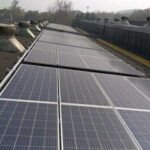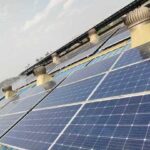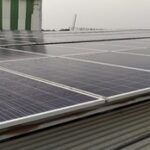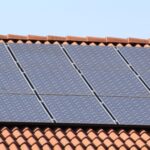How Azimuth Angle Impacts Solar Panel Efficiency for Homes, Industries, and Commercial Buildings
How Azimuth Angle Impacts Solar Panel Efficiency for Homes, Industries, and Commercial Buildings
Designing layout for a solar installation is an expert job and needs to be done with utmost care. There are two important considerations while designing solar panels installation , one is inclination of the panels and another is direction. The angle of tilt should be latitude of the place wherever the installation is being done to optimize the radiation of solar and direction should be true south.
While angle of tilt is easy to control ,the direction is not always possible to be maintained. If the building roof on which solar panels are to be installed is such that structure installation is not possible in true south direction then there is bound to be loss of generation. We have seen a lot of installations where because of paucity of space and ignorance of installer and client the solar plants are installed without giving a thought to tilt & direction and only aesthetic considerations are valued . This way though the client can be impressed but the very purpose of installing solar plant to generate rated power is compromised.
In case it is necessary then also the installer should try and reduce the impact of azimuth . To have a clear picture of loss of generation the following table may be used.
Suggested Articles

Sanctioned Load & Rooftop Solar: Everything You Need to Know
Learn why sanctioned load is crucial before rooftop solar installation. Understand its role, process, and impact on solar panel efficiency and subsidy eligibility.

Fire Hazard in a Solar Setup at Rice Mill, Kaithal – Case Study and Safety Insights
A recent fire incident at a rice mill in Kaithal highlights the critical importance of safety in solar installations. This case study analyzes the root causes, system faults, and preventive actions that can help industries avoid similar hazards in their solar setups.

How to Improve Solar Panel Performance for Optimal Energy Output
Performance degradation in solar panels reduces energy output over time. This guide explains how to factor in degradation when calculating annual yields, ensuring accurate estimates for residential, commercial, and industrial solar installations.

How DISCOMs Implement Net Metering for Solar Power Plants
Discover the process of net metering implementation by DISCOMs for solar power plants. Understand the benefits, billing mechanism, and how it maximizes solar energy utilization.

How Are Solar PV Modules Made? Complete Guide to the Manufacturing Process
Choosing the right solar panels can be confusing with so many options in the market. This guide simplifies solar panel selection by comparing types, efficiency ratings, and cost factors. Whether for your home, business, or industry, learn how to make an informed decision and maximize the return on your solar investment.

Solar Panel Installation on Tiled Roofs: Complete Homeowner Guide
When you’re ready to install solar panels on your home, there are many factors that will determine the unique design and cost of your solar system. Various roof types require different processes for installation. For example, lightweight tile roofs can present unique challenges and considerations for a solar installer. Here are a few things you need to know before adding solar energy to your tile roof.

Solar Projects Challenges in India: Module Supply Shortages and Policy Delays Slow Growth
India’s utility-scale solar projects face delays due to module supply shortages and policy challenges, impacting the growth of renewable energy.

Solar Cell Technology: Monocrystalline vs Polycrystalline vs Thin-Film
Explore the different types of solar cells, including monocrystalline, polycrystalline, and thin-film, and learn their efficiency, applications, and benefits for solar energy systems.